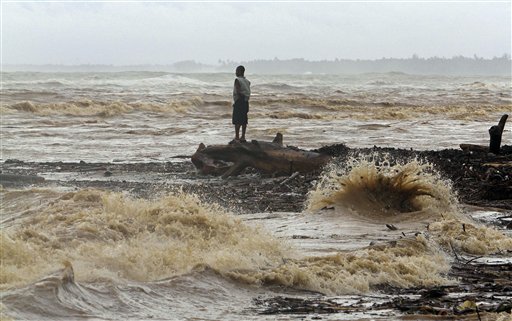 Wilmington, NC – People stocked up on food, boarded windows and gassed up their cars Tuesday as Hurricane Irene threatened to become the most powerful storm to hit the East Coast in more than a decade.
Wilmington, NC – People stocked up on food, boarded windows and gassed up their cars Tuesday as Hurricane Irene threatened to become the most powerful storm to hit the East Coast in more than a decade.
Subscribe to our Daily Roundup Email
Water, bread and batteries disappeared from store shelves. Lines formed at the pump. From Florida to Maine, residents were told to brace for flash flooding and power outages.
Hundreds of miles south, Irene swirled through the Caribbean, giving a glimpse of what was to come. Homes were inundated with water, residents took refuge in schools and churches, and more than a million people were without electricity. One woman was killed in Puerto Rico.
Forecasters warned it could get worse: The storm was likely to strengthen into a Category 4 monster by the time it makes a landfall in the U.S. this weekend, most likely hitting North Carolina. Irene could crawl up the coast Sunday toward the Northeast region, where residents aren’t accustomed to such storms.
Officials dusted off evacuation plans and readied for the first hurricane to threaten the U.S. in three years. It’s been more than a decade since the East Coast has been hit by a major hurricane, considered a Category 3 with winds of at least 111 mph (179 kph).
Though Irene was downgraded to a Category 1 storm on Tuesday with maximum sustained winds of 90 mph (145 kph), forecasters believed it would strengthen over warm waters.
“I’m not panicking, but I was born and raised here,” said Peggy Temple, of Wrightsville Beach, N.C.
She bought sandbags to protect her first-floor property from flooding.
“I know the drill. You want to be ready, because you can’t be putting up storm shutters with 100 mile an hour winds and torrential rain,” she said.
Nearby, scores of bronzed sunbathers strolled around in bathing suits and towels, soaking up one of the last weeks of the summer tourist season. Traffic was typical for this time of year, with more cars headed toward the beach than away from it, though some vacationers had started canceling weekend hotel reservations.
On Ocracoke Island, tourists and residents were told to leave by Thursday so the island’s ferries wouldn’t be overwhelmed. But many on the 16-mile-long barrier island would probably stay, said Tommy Hutcherson, who serves on the local board that issues evacuation orders.
“I’ll be here,” said Hutcherson, who has lived on Ocracoke for 29 years. “A lot of the locals will choose to stay.”
Bob Eure, who works at the Island Tackle & Hardware in Carolina Beach, said people streamed in all day, buying flashlights and five-gallon gas cans to fill with water. Others bought fish tackle.
“With the water stirred up, the fish will bite better,” he said.
Still, Eure said, people are worried, particularly those who have moved to the area from other parts of the country.
“It’s still too early and we don’t know where it’s going to hit, but everyone is getting ready. You have to prepare yourself for the storm,” he said.
The last hurricane to hit the U.S. was Ike in 2008. The last Category 3 or higher to hit the Carolinas was Bonnie in 1998, but caused less damage than other memorable hurricanes: Hugo in 1989, Floyd in 1999 and Isabel in 2003.
Though a Category 2, Isabel cut a new inlet through Hatteras Island and killed 33 people.
In Washington, the National Park Service considered postponing Sunday’s dedication of the new Martin Luther King Jr. memorial. Hundreds of thousands of people were expected on the National Mall.
As far north as Maine, residents were told they could be affected by Irene.
“We need to remind people, hurricanes are not just a Southern thing. This could be the Mid-Atlantic and the northeast coast,” Craig Fugate, head of the Federal Emergency Management Agency, said during a conference call with reporters. “We’ve got a lot of time for people to get ready, but we don’t have forever.”
Even if the storm stays offshore, it could cause flooding and power outages all along the Eastern Seaboard. National Hurricane Center director Bill Read drew comparisons to a 1938 hurricane that also approached from the South and killed 682 people in New England.
“We’re very concerned about what’s going to happen in New England,” Read said.
The hurricane’s projected path has gradually shifted farther east. Forecasters initially expected the storm to hit Florida.
Irene has already wrought destruction across the Caribbean. In Puerto Rico, more than a million people were without power, and a woman died trying to cross a swollen river in her car. President Barack Obama has declared an emergency there. Hundreds were displaced by flooding in the Dominican Republic, forced to take shelter in schools and churches.
